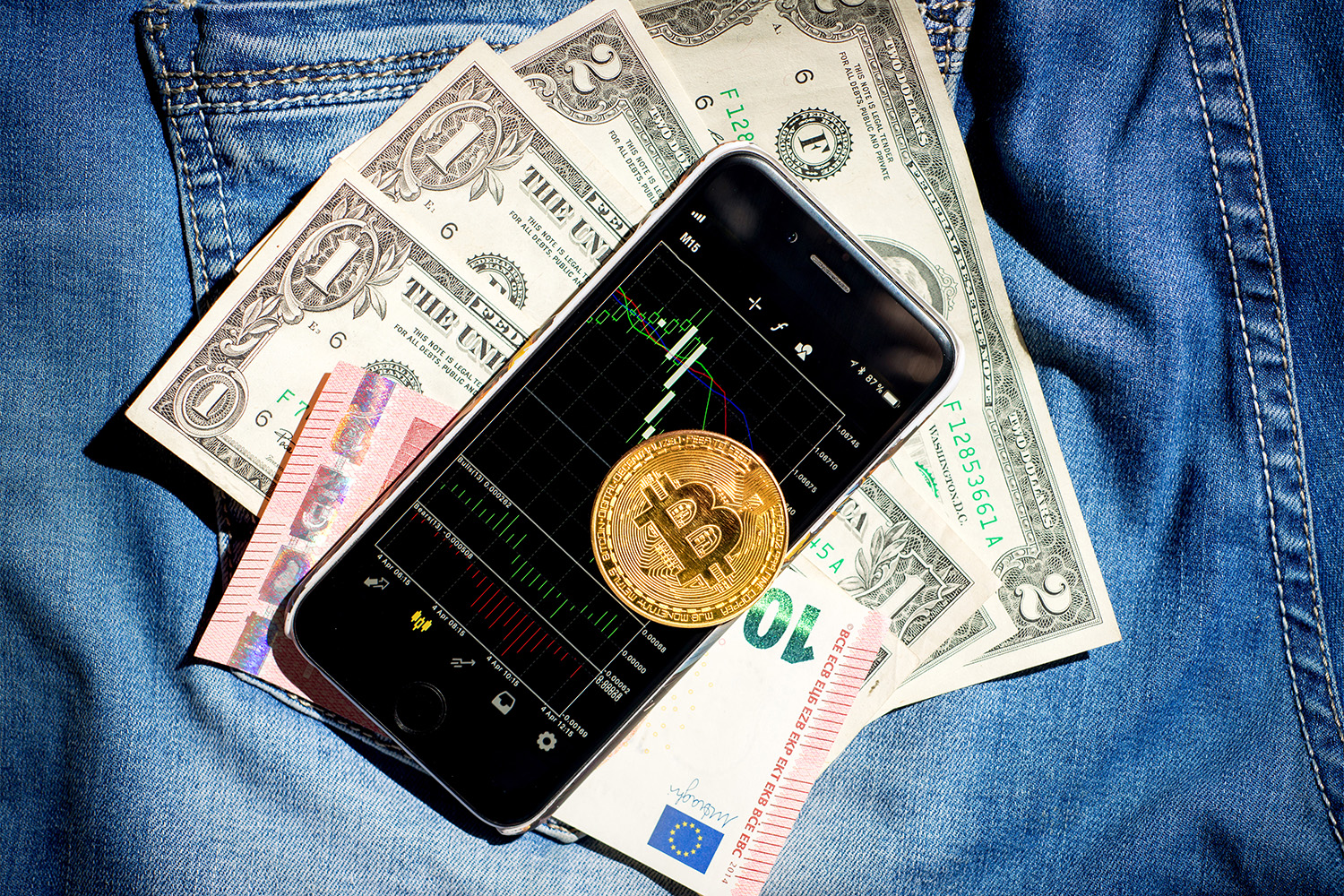While the fever dream of crypto-optimists is a world where people can use bitcoin to buy lattes and pay rent, we’re not quite there yet.
Instead, people have bills to pay, savings to grow, and real-world purchases. And while spending ramps for cryptocurrencies grow yearly, there’s still a way to go before you can use Bitcoin instead of fiat money such as USD for most purchases.
Fortunately, it’s getting easier to convert cryptocurrency into cash. However, each method brings different advantages and disadvantages, so it’s essential to know the ins and outs of each before deciding which is best for you.
Sell Directly for Fiat on an Exchange
The most common way to convert your crypto is to sell it directly for fiat currency on a crypto exchange like Coinbase, Kraken, or Gemini. If you’re looking to cash out Bitcoin (BTC), Ethereum (ETH), or other digital assets, most all exchanges will allow you to do so.
When you sell crypto on an exchange, you’ll usually need to pay a transaction fee, which is generally a percentage of the total transaction.
If you wish to sell Bitcoin or convert Bitcoin you have in your crypto wallet, you won’t end up with the exact amount you see in a conversion — you’ll have to consider the brokerage fees.
Exchanges employ automated systems to match buyers and sellers, so you’ll need to be prepared to accept the best-offered price.
They use an order book to check orders and list all the buy and sell orders placed on the exchange. The order book will show you the current best offers to buy or sell an asset and the amount available at that price.
Sell Via Peer-to-Peer Trading (P2P)
Another way to cash out your cryptocurrency is to sell it indirectly for fiat currency by trading with another person.
Several peer-to-peer platforms in recent years have allowed crypto holders to find buyers willing to pay cash for their digital assets. Paxful, LocalBitcoins, and Bisq are some of the more popular P2P marketplaces.
The advantage of peer-to-peer exchanges is that they usually have lower fees than selling on an exchange. Furthermore, trading P2P gives more flexibility in payment methods and negotiating prices.
When you sell your crypto, you have the choice to accept fiat, PayPal, bank transfer, or even goods and services in exchange for your digital currency. The disadvantage of P2P trading is that it can be more time-consuming than other methods since you need to find a buyer willing to trade with you.
Since there’s no intermediary or custodian managing asset transfers along the way, P2P trades come with lower fees from escrow and network transaction costs. Still, it’s significantly cheaper than using centralized exchanges.
Of course, the most direct P2P exchange would be selling to someone in-person. For example, say your friend Alice wants to give you fiat for 0.5 of your bitcoin. You can transfer the digital currency to her wallet, and once it confirms on the network, she can hand you the cash.
Use a Crypto ATM
Over the past few years, Bitcoin ATMs have increased in many major cities worldwide. These machines allow you to insert cash and receive bitcoin in return, or vice versa.
While some ATMs only support buying and selling BTC, many also support altcoins such as ETH, LTC, and BCH. In 2017, there were only around 1000 Bitcoin ATMs around the world. As of 2022, there are almost 40,000, an increase of 4000%.
Crypto ATMs provide invaluable access to individuals in developing countries or to those who don’t have access to the traditional financial system. Over two billion people worldwide are unbanked, meaning they don’t have access to a conventional bank account.
Unfortunately, it’s not profitable to offer banking services to low-income individuals, so banks generally don’t bother. However, with Crypto ATMs, anyone can easily buy and sell cryptocurrency for cash.
In addition, installation is easy, and upkeep is relatively cheap, making Crypto ATMs a viable option for business owners in developing countries.
The advantage of using a Crypto ATM is that it’s quick and easy. You can usually receive your cryptocurrency within seconds.
The main disadvantage of using Crypto ATMs is that fees are generally relatively high. And while some charge fees as low as 3%, many have charges upwards of 10 percent or even more.
So if you’re looking to cash out a large sum of cryptocurrency, you could lose a significant amount of money to fees.
Crypto ATMs are all about access. It’s instant, local, and easy to use for people who might not have access to the traditional financial system.
The Elephant in the Room: KYC and AML
Cryptocurrency’s ethos was founded on the idea of decentralization and anonymity. Cypherpunks and crypto developers are kindred spirits; they both believe in the power of cryptography to upend traditional systems and give individuals more freedom.
However, as cryptocurrency has become more mainstream, governments and financial institutions have begun to pay more attention to it. And in many cases, they’ve been cracking down.
When any asset or technology starts to create opportunities for financial profit, you can bet that institutions will want to get involved and use their power to do so.
We see that shift in real-time. Over the past few years, governments and government agencies have increased cryptocurrency regulation.
Know-your-customer (KYC) and anti-money laundering (AML) regulations are two more prominent rules.
KYC
Under KYC rules, businesses must verify the identity of their customers before onboarding. This generally means collecting and storing customer data such as name, address, birth date, and government ID.
For cryptocurrency exchanges, this has meant that many have had to implement strict KYC measures, such as requiring customers to upload a photo of their government ID.
The problem with KYC is that it goes against the decentralized ethos of cryptocurrency. It’s also very intrusive and puts customer data at risk of being hacked or stolen.
There are several instances of hackers and bad actors stealing customer data from exchanges, leading to millions of dollars worth of crypto and complete or partial identity theft.
Regulators believe KYC is essential for preventing bad actors from financial crimes, and while that may be true, there’s no question that it comes at the expense of customer privacy.
AML
Anti-money laundering (AML) rules are similar to KYC in that they require businesses to verify the identity of their customers. The difference is that AML rules also need firms to monitor their customers’ activity for suspicious behavior.
If an entity flags a user for suspicious activity, they may account freeze their account, close it, or report it to the authorities.
Often, in the case of cryptocurrency, AML laws have led exchanges to freeze or close accounts without notice and without any way for users to appeal the decision. It’s unfortunate, but leveraging AML laws to crack down on customers without due process is all too common in finance.
AML laws prevent financial crimes such as money laundering, terrorist financing, and fraud. But like KYC, they come at the expense of customer privacy.
Furthermore, certain financial institutions, governments, and regulatory bodies have been known to abuse AML laws to target innocent people and silence dissent.
On Regulation
Regulation is essential, but it’s a double-edged sword. On the one hand, regulation can help prevent crime and protect consumers. But on the other hand, it can create a security risk for users, as their information, if left in the wrong hands, can be used against them.
The best way to protect yourself is to know the risks and take steps to mitigate them. When it comes to cashing out crypto, that means being aware of KYC and AML rules and taking precautions with your data.
It also means using a reputable exchange or service that takes security seriously.
Governments and regulatory agencies believe KYC and AML laws are necessary to prevent tax evasion, terrorism, and other financial crimes.
But this process is as clunky as it is inefficient. Industry experts believe that “false positives” — or people being flagged for suspicious activity when they’re not doing anything wrong — is alarmingly high.
Some estimate that false positives may account for over 90% of all AML-related flags.
Regulation, in general, is like chasing a moving target. Bad actors find ways to adapt and commit new crimes when rules are established to prevent one type of crime. It’s a never-ending cycle; while regulation is essential, it’s not a perfect system.
Takeaways
There are myriad ways to cash out crypto, each with unique risks and benefits. There’s no one-size-fits-all solution, from selling to P2P trading to using a Crypto ATM. The best way to cash out your crypto is the way that works best for you.
Companies are creating new methods of cashing out crypto, and as the industry matures, we can expect to see more options become available.
As such, it’s essential to stay up-to-date on the latest offerings. If you’re looking to learn more about cryptocurrency and how it works, you’re in the right place.
American Crypto Academy is run by a team of experts, and we’re dedicated to making cryptocurrency and the blockchain easy, with educational resources and professional programs taught by carefully chosen industry professionals.
Check out our blog or check out our other community resources to learn more.
Sources:
How to Reduce False Positives in AML Transaction Monitoring – Blog | Unit21





